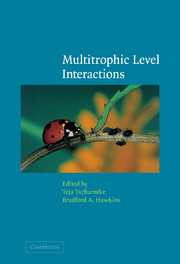Book contents
- Frontmatter
- Contents
- List of contributors
- 1 Multitrophic level interactions: an introduction
- 2 Plant genetic variation in tritrophic interactions
- 3 Multitrophic/multispecies mutualistic interactions: the role of non-mutualists in shaping and mediating mutualisms
- 4 Tritrophic interactions in tropical versus temperate communities
- 5 Endophytic fungi and interactions among host plants, herbivores, and natural enemies
- 6 Multitrophic interactions in space: metacommunity dynamics in fragmented landscapes
- 7 The chemical ecology of plant–caterpillar–parasitoid interactions
- 8 Canopy architecture and multitrophic interactions
- 9 Tritrophic below- and above-ground interactions in succession
- 10 Multitrophic interactions in decomposer food-webs
- Index
6 - Multitrophic interactions in space: metacommunity dynamics in fragmented landscapes
Published online by Cambridge University Press: 08 August 2009
- Frontmatter
- Contents
- List of contributors
- 1 Multitrophic level interactions: an introduction
- 2 Plant genetic variation in tritrophic interactions
- 3 Multitrophic/multispecies mutualistic interactions: the role of non-mutualists in shaping and mediating mutualisms
- 4 Tritrophic interactions in tropical versus temperate communities
- 5 Endophytic fungi and interactions among host plants, herbivores, and natural enemies
- 6 Multitrophic interactions in space: metacommunity dynamics in fragmented landscapes
- 7 The chemical ecology of plant–caterpillar–parasitoid interactions
- 8 Canopy architecture and multitrophic interactions
- 9 Tritrophic below- and above-ground interactions in succession
- 10 Multitrophic interactions in decomposer food-webs
- Index
Summary
Introduction
The distribution and abundance of consumers are necessarily limited by the distribution and abundance of their resources. With the exception of obligate mutualisms, a species at a higher trophic level in a food chain will occupy a subset of the locations occupied by species at lower trophic levels (Holt, 1995, 1997). In order to persist, species at higher trophic levels must be able to colonize, at a sufficiently high rate, sites occupied by populations of the lower trophic level species. The interaction may be spatially dynamic in both directions because species at any trophic level may influence the dynamics of one another. Once the interacting species occur as local populations in a shared habitat patch, phenomena traditionally addressed by studies of multitrophic interaction take place. Thus for species living in fragmented landscapes it is critical to keep in mind both processes occurring at large spatial scales and those occurring within a single habitat patch or local population. This chapter is about the interplay between spatial dynamics and multitrophic level interactions.
Species involved in a trophic interaction, such as the interaction between a predator and its prey, are influenced directly and indirectly by the trophic levels above and below them. The indirect effect of a non-adjacent trophic level can be either positive or negative.
- Type
- Chapter
- Information
- Multitrophic Level Interactions , pp. 124 - 147Publisher: Cambridge University PressPrint publication year: 2002
- 23
- Cited by



